Polymerization of halogen-containing monomers using siloxane surfactant
a technology of halogen-containing monomers and surfactants, applied in the field of polymerization of halogen-containing monomers, can solve the problems of affecting the molecular weight and other properties of products, perfluorinated surfactants have recently become the focus of increasing scrutiny, and the reaction rate is substantially reduced
- Summary
- Abstract
- Description
- Claims
- Application Information
AI Technical Summary
Benefits of technology
Problems solved by technology
Method used
Image
Examples
examples 1-9
Vinylidene Fluoride Homopolymerization
In the following experiment, the siloxane surfactant structure was varied (triblock copolymer, trisiloxane, polycarboxylic acid salt, polyethylene oxide, poly(ethylene oxide / propylene oxide)) in the homopolymerization of vinylidene fluoride.
Into a 2-liter stainless steel horizontal autoclave was charged 850 grams of deionized water at room temperature. The autoclave was closed, pressurized with nitrogen to about 240 kPa, heated to 80° C. under agitation and then vented to atmospheric pressure. Approximately 135 mL of vinylidene fluoride (VF2) monomer, which had been maintained at about −6° C., and of approximate density of 0.86 g / mL, was charged into the autoclave to a pressure of about 3,800 kPa. An aqueous potassium persulfate solution (20 mL, 3 wt. % in deionized water at 6° C.) as radical initiator was fed into the autoclave at a rate of 5 mL / min. to begin polymerization. During the persulfate feed, the pressure decreased and the feed rate w...
examples 10-15
Vinylidene Fluoride Homo- and Co-Polymerization with Potassium Persulfate
Homopolymerization of VF2 (Examples 10 and 11) was performed as above, or copolymerization of VF2 with either hexafluoropropylene (“HFP”, Examples 12, 13 and 14) or chlorotrifluorocthylene (“CTFE”, Example 15). Reagent preparation and polymerization were performed as in Examples 1-9. The reaction was set up with an initial charge of 0.1 g of sodium formaldehyde sulfoxylate in the two-liter autoclave reactor. The reaction conditions and product data are reported in Table 3.
TABLE 3Polymerization Homo- and Co-Polymerization with PotassiumPersulfate.LatexSurfactantLatexstabilityhandSolidRatejcoagulumExampleWt. %monomerspHwt. %imL / minwt. %10Silwet ® L77VF2 2.2q26.34.03<0.40.1511Aldrich 44, 203-8VF27.02n229.571.20.1612kAldrich 44, 203-8VF2 / HFP3.81a278.56.00.3213kSilsoft ® 810VF2 / HFP(q)25.34.38<0.20.3814kSilsoft ® 810VF2 / HFP(q)35.66.037.00.5815mSilwet ® L77VF2 / CTFE(q)32.21.970.420.28hWt. % according to PVDF....
examples 16-17
Polymerization with Hydrocarbon and Siloxane 20 Surfactant Combinations
Reagent preparation and polymerization were performed as in Examples 1-9. Comparative Examples 3, 4 and 5 reflect polymerizations in the presence of hydrocarbon surfactants alone Examples 16 and 17 included surfactant combinations comprising a siloxane surfactant and a non-fluorinated hydrocarbon surfactant. The hydrocarbon surfactants were a poly(ethylene oxide / propylene oxide) block copolymer (Pluronic® L92) and a poly(ethylene oxide) tert-octylphenyl ether (Triton® X405). The re action conditions and product data are reported in Table 4.
TABLE 4Polymerization with Hydrocarbon and Siloxane SurfactantCombinationsSiloxaneHydrocarbonsurfactantSolidRatejLatex stabilityhExampleSurfactant / Wt. %wt. %weighti, %mL / mincoagulum wt. %ComparativePluronic ® L92none29.28.20not stable; >60%Example 30.287ComparativePluronic ® L92none28.25.28not stable; >70%Example 40.67ComparativeTriton ® X405none28.05.82stable; 2.10Example 50.2...
PUM
| Property | Measurement | Unit |
|---|---|---|
| Pressure | aaaaa | aaaaa |
| Volume | aaaaa | aaaaa |
| Fraction | aaaaa | aaaaa |
Abstract
Description
Claims
Application Information
 Login to View More
Login to View More - R&D
- Intellectual Property
- Life Sciences
- Materials
- Tech Scout
- Unparalleled Data Quality
- Higher Quality Content
- 60% Fewer Hallucinations
Browse by: Latest US Patents, China's latest patents, Technical Efficacy Thesaurus, Application Domain, Technology Topic, Popular Technical Reports.
© 2025 PatSnap. All rights reserved.Legal|Privacy policy|Modern Slavery Act Transparency Statement|Sitemap|About US| Contact US: help@patsnap.com



